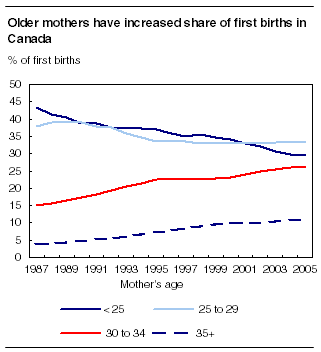Common menu bar links
Study: Health and development of children of older first-time mothers
Archived Content
Information identified as archived is provided for reference, research or recordkeeping purposes. It is not subject to the Government of Canada Web Standards and has not been altered or updated since it was archived. Please "contact us" to request a format other than those available.

It is increasingly common for Canadian women to delay childbearing. First-born children of older mothers (aged 35 or over) did not differ significantly from children born to mothers aged 25 to 29 with respect to a number of health, behaviour and cognitive outcomes measured up to the age of 5, with a few exceptions.
Trends in women's age at first child's birth
Over the past 20 years in Canada, the proportion of first births occurring among women aged 35 and older has increased. In 1987, only 4% of first births occurred among women aged 35 and up; by 2005, the rate had nearly tripled to 11%. At the same time, the proportion of first births occurring among women in their early 30s increased from 15% to 26%. Medically speaking, older mothers are at increased risk of pre-natal and birth-related complications. Less is known about the relationship between advanced maternal age and the child's development.

Child's physical health and development
In the study, first-born children of older mothers were as likely as children of mothers aged 25 to 29 to have received special care at birth, to be in excellent or very good health during early childhood (ages 0 to 5), or to be diagnosed with asthma. They shared similar timing with respect to saying their first word and taking their first step and had similar average scores in physical aggression, emotional disorder and anxiety, and hyperactivity and inattention. Children of older mothers also had similar scores in receptive vocabulary, number knowledge, and copying and symbol use as children of reference mothers.
Note to readersThe National Longitudinal Survey of Children and Youth (NLSCY) is conducted by Statistics Canada and sponsored by Human Resources and Social Development Canada. This study took its sample from the early child development cohorts of the NLSCY that are interviewed at ages 0 to 1 and followed every two years until the ages of 4 and 5. Responses are provided by the Person Most Knowledgeable about the child (known as the PMK), usually the child's mother. This study pooled the cohorts introduced in Cycles 3 through 6 (1998 through 2005), and retained for the analysis only the first-born children whose biological mother was interviewed at each cycle. This resulted in a final sample of 3,382 0- to 1-year old children who represented about 556,000 children in the Canadian population. Of these children, 2,365 were re-interviewed at ages 2 to 3, and 1,705 were interviewed a third time at ages 4 to 5. The main comparisons in the study were made between first-born children of older mothers (aged 35 or over), and first-born children of mothers aged 25 to 29 (the reference group). |
However, there were a few outcomes for which children of older mothers differed significantly from children of mothers aged 25 to 29. Even after controlling for a number of factors, children of older mothers were more likely to be late to first sit up by themselves, to score lower on the Motor and Social Development scale at ages 2 to 3, and to have lower positive behaviour scores at ages 4 to 5 than children of mothers aged 25 to 29.
Advanced maternal age and birth-related risks
During the study period, a greater proportion of first-born children of older mothers (aged 35 or over) were exposed to several birth-related risks compared with first-born children of mothers aged 25 to 29.
About 23% of children of older mothers had a mother who suffered from hypertension during pregnancy compared with 13% of children of mothers aged 25 to 29.
About 40% of children of older mothers were delivered by caesarean section, almost twice the proportion of children of mothers in the younger group (23%). And 17% of children of older mothers were born pre-term, compared with 11% in the younger group.
At the same time, children of older mothers were significantly more likely to have been breastfed and breastfed longer compared with children of mothers in the younger group. About 43% of children of older mothers were breastfed for more than six months compared with 26% of children of mothers aged 25 to 29.
Socio-demographic profile
Children of older mothers shared a similar socio-demographic profile with children of mothers aged 25 to 29. About 13% of both groups had a mother with a high school diploma or less, and 6% had a mother who was a single parent.
About 12% of children of older mothers lived in a low-income household, virtually the same proportion as children of mothers aged 25 to 29.
Definitions, data sources and methods: survey number 4450.
The article "The Children of Older First-time Mothers in Canada: Their Health and Development" is now available as part of the Children and Youth Research Paper Series (89-599-MWE2008005, free). From the Publications module of our website, choose Free Internet publications, then Children and Youth.
For more information, or to enquire about the concepts, methods or data quality of this release, contact Client Services (toll-free 1-800-461-9050; 613-951-3321; fax: 613-951-4527; ssd@statcan.gc.ca), Special Surveys Division.

